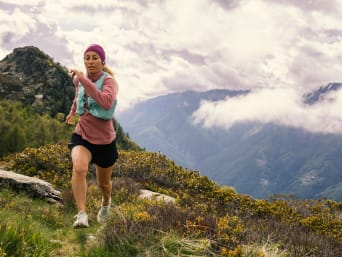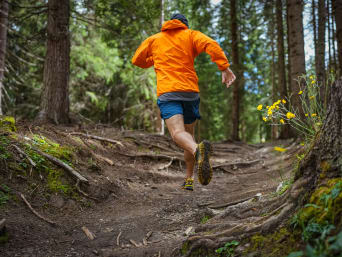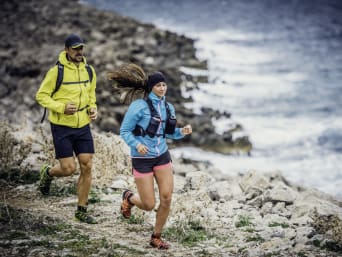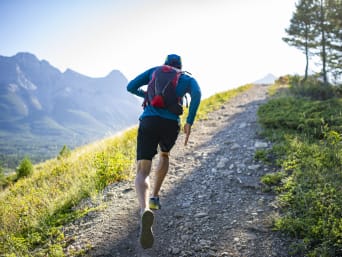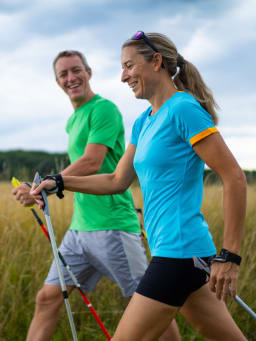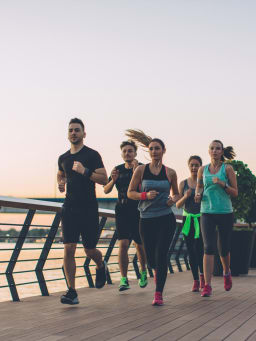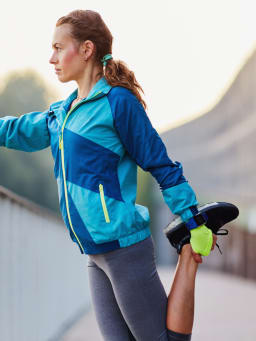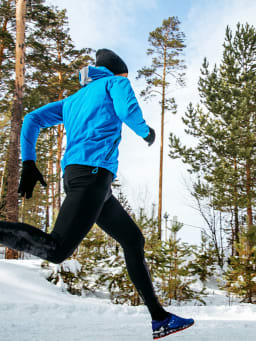Trail running for beginners: everything you need to know
Trail running is the perfect sport for running enthusiasts, as it offers a wide range of new challenges and experiences for runners. You can enjoy running on soft terrain in a forest or try overcoming more challenging trails in the mountains. Running off-road may be the perfect thing for you if you are looking for new running routes. In this article we will explain what you need to keep in mind when going on a trail run as a beginner and what you will need to take with you.
What is trail running?
Trail running is running on mostly non-surfaced, unpaved paths and roads. You don't necessarily need to run long distances or climb to the top of a mountain to go on a trail run. Going on a run on a forest trail that leads you to a lake would also count as a trail running. Trail running takes you along trails through forests, meadows and on gravel roads that go through parks or woodland, as well as stony paths in the mountains or even on sand. Depending on the distances you want to cover or the terrain you are going to be running on, this type of running can fall into different categories.
Urban trail running is the ideal option if you already run regularly around the town or city where you live and want to try something new. Starting from where you live and depending on your place of residence, first cover a certain distance on tarmac before going into a park or nearby forest. This form of trail running is therefore also known as urban trail running.
Cross-country is your next challenge, where you will run solely in the countryside on different terrains. You will need to adapt to uneven terrains and often have to overcome certain hilly or mountainous parts of the trail. However, you can also run on paved paths, hiking trails or mountain bike trails.
Adventure trails: this is the most adventurous and athletically demanding type of trail running. Runners usually look for challenging terrains or make their own route. The unpaved and often difficult terrains with natural obstacles require not only physical fitness, but also a lot of care and coordination.
Important: To preserve the natural environment and protect the local wildlife, many trail running experts advise against leaving marked trails. Especially in nature reserves you should follow the guidelines and stay on the hiking or mountain bike trails or tracks.
There are also forms of trail running where you can compete with other runners to achieve set targets and times. In contrast, ultramarathons involve covering long distances, which are usually a lot longer than a regular marathon.
The health benefits of trail running
Trail running has the same health benefits as other forms of running. Regular endurance training will strengthen your cardiovascular system, can improve lung health and it will also strengthen your leg and gluteal muscles.
Compared to jogging in an urban area, trail running can improve your health as you offer your body new stimuli. The surface on forest or mountain bike trails is easier on your joints, and you can work your different muscles groups. It will also help you to improve your posture.
The tendons and ligaments are also put under greater strain due to the more demanding terrain. Trail running becomes an effective strength workout, depending on the type of surface you are running on and how hilly or flat the trail is.
How to get started with trail running
As the uneven terrain of trail running places a variety of demands on your body, most orthopaedists and many trail running experts recommend that complete beginners start by jogging and running somewhere in an urban area. A stable musculoskeletal system and basic endurance are essential to avoid injury when running off-road.
Firstly, it is important to learn the correct running technique and to specifically train your legs, glutes and core muscles before setting off on a longer trail run. For beginners it is recommended to first see a doctor before starting trail running. The doctor will be able to check to make sure that your cardiovascular system and your joints are able to cope with the strain of the different terrains.

Running experts or orthopaedists can help you to create a targeted training plan for trail running. Specialist shops can offer you advice on what you will need or tips on great trails.
In the articles below we also discuss how you can get started with running and how you can accomplish new training goals:
Everything you will need for trail running
There are different challenges depending on whether you would like to run on tarmacked or paved roads and paths or on non-surfaced trails. If you are running a short distance around a lake or on a dirt track for the first time, your normal running clothes and shoes are usually sufficient. However, if you want to run more often on non-surfaced routes, it is advisable to invest in special trail running gear.
Trail running essentials list
Clothes & shoes
A pair of trail running shoes
Running tops or t-shirts
A pair of running trousers or tights
Running socks
Windproof/waterproof jacket
Fleece jacket
Running vests, if needed
Tube scarf
Running gloves
Hat/cap
A pair of (running) sunglasses
Basic essentials
Running backpack
Running poles, if needed
First aid kit (including blister plasters if necessary)
Foil emergency blanket
Suncream
A packet of tissues
Food & drink
Water bottle or a hydration bladder or hydration belt with enough water for your run
Energy bar or energy gel
What you shouldn’t forget
Mobile phone
GPS watch/running watch, if needed
Topographical map of the region, if applicable
Headlamp depending on visibility
ID
Health insurance card, if applicable
Money

Whether you are going on a long or a short trail run will determine what you need to take with you. However, it is important to remember not to take too much with you, as running can become more difficult when carrying a lot of things. When going on a cross-country run you will cover long distances, which means you will be out for several hours. On longer routes with more challenging terrains, you will need more water and food and, depending on the weather conditions, warm or windproof and waterproof clothing. So always pack accordingly to your planned route and your individual needs.
How to find the perfect pair of trail running shoes
Trail running shoes are perfectly adapted to the conditions of the terrain. They have a non-slip sole and they are light and comfortable so that you can go running. Their robust outsole usually has a rougher and deeper tread than normal running shoes. The midsole should be firm enough to keep the back of your foot in place. It should also help to stop you from twisting your ankle, even on terrain with sharp stones and tree roots. Trail running shoes are often more lightly cushioned than regular running shoes for asphalt surfaces.
If you are new to trail running, then you should go for a pair of trail running shoes that are comfortable and ideal for off-road terrain. However, if you plan on running frequently or solely off-road and are always looking for new challenges, you should get a pair of trail running shoes that are suitable for different surfaces and weather conditions:
On trails with soft or muddy ground, trail running shoes with a thicker tread and a firmer sole are advisable to prevent slipping.
For a stony terrain, shoes with a flatter and stronger cushioning can be an advantage.
It may also be worth investing in a pair of breathable and waterproof trail running shoes.

When should trail running shoes be replaced? Generally, you should get a new pair of running shoes after running around 600 to 800 kilometres. This will ensure that you can continue to benefit from the support and great fit.
Finding the perfect running backpack
A running backpack should sit tightly on your body like a waistcoat and it shouldn’t get in the way when running. Nevertheless, it should offer enough space for food, your essentials and a windbreaker if necessary. The capacity of your running rucksack should match the length of the chosen route:
Small backpacks that can carry up to 2 to 5 litres are suitable for carrying a hydration system, your food and a thin jacket for a short distance run.
If you are going to be running a longer distance or taking part in a trail race, you will need a backpack that can carry around 8 to 10 litres.
From 15 litres, you are often well equipped even for endurance events that take place over a series of days.
Helpful trail running tips for beginners
Even if you go running regularly, you should still start off with easier and shorter trails. As with jogging and running in general, you should maintain a steady pace, not overexert yourself and gradually build up the intensity of your training.
Below we have summarised some tips for trail running beginners:
To start with, you should continue running on your regular running routes and then gradually move onto smaller non-surfaced routes. It is best to start with shorter trails (approx. 5 kilometres) and less demanding routes such as on softer terrains like forest and field trails.
Find out about the planned route (altitude, difficulty, dangerous areas) and double check the weather forecast.
Adapt your pace to the conditions and do not overdo it. It may be advisable to switch to walking from time to time if the trail becomes quite steep. Don’t forget that on longer trails you will also need to run all the way back to the starting point.
Particularly beginners can benefit from running in a group, as you may even be able to learn valuable tips about the right technique from experienced trail runners. You can also motivate each other and provide reassurance, in case something happens, for example, after a fall another person can call for help or provide first aid.
Always pay attention when running and be aware of your surroundings. Make sure to not look down at your feet, as you should concentrate on the route and looking ahead so that you can quickly spot obstacles or difficult terrains. If you would like to enjoy the view, it is best to take a short break rather than trying to focus on two things at once.
Conclusion: how to get started with trail running
There are different types of trail running. Urban trail running is on routes in and around towns and cities. It is ideal for beginners to help them gradually familiarise themselves with this new form of running. Cross-country trails are on forest and mountain bike trails that give you the opportunity to master new challenges, explore varied routes and enjoy the beauty of the countryside. It is important that you proceed slowly when changing from tarmac roads to unpaved and demanding trails. In order to avoid any injuries make sure to gradually increase your pace, training duration, intensity and don't set yourself too many goals.
______________________________________________
Resources and further information
https://www.rei.com/learn/expert-advice/trail-running-tips.html
(Last accessed on 04.01.2024)
https://www.runnersworld.com/trail-running/a26659505/trail-running-tips/
(Last accessed on 04.01.2024)
https://www.self.com/story/trail-running-tips
(Last accessed on 04.01.2024)
https://www.trailrunnermag.com/training/10-tips-for-trail-running-beginners/
(Last accessed on 04.01.2024)
The image sources in this text are in chronological order:
Cover photo: iStock.com/swissmediavision
1. Image in text: iStock.com/piola666
2. Image in text: iStock.com/vm
3. Image in text: iStock.com/AscentXmedia
